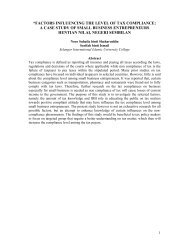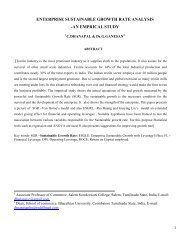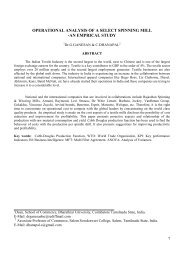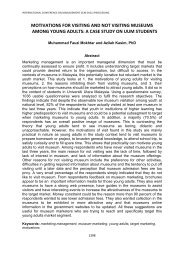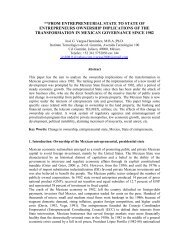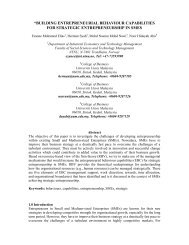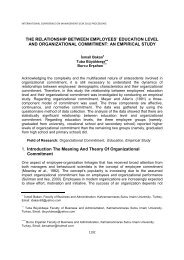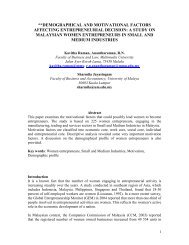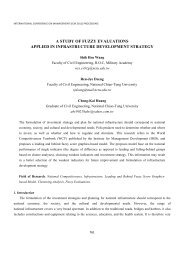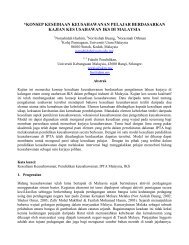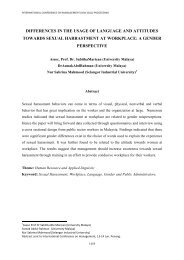SECURITY FEATURES IN THE GATED COMMUNITY HOUSING ...
SECURITY FEATURES IN THE GATED COMMUNITY HOUSING ...
SECURITY FEATURES IN THE GATED COMMUNITY HOUSING ...
You also want an ePaper? Increase the reach of your titles
YUMPU automatically turns print PDFs into web optimized ePapers that Google loves.
<strong>IN</strong>TERNATIONAL CONFERENCE ON MANAGEMENT (ICM 2011) PROCEED<strong>IN</strong>G<br />
<strong>SECURITY</strong> <strong>FEATURES</strong> <strong>IN</strong> <strong>THE</strong> <strong>GATED</strong> <strong>COMMUNITY</strong> HOUS<strong>IN</strong>G<br />
DEVELOPMENT<br />
Zurinah bt Tahir¹ and Khadijah bt Hussin²<br />
Department of Land Administration and Development<br />
Universiti Teknologi Malaysia, Skudai Malaysia<br />
Public safety, an important national agenda, has featured prominently in the 10 th Malaysia Plan. Various strategies<br />
have been formulated towards creating a safer environment in which to live and work. Crime affects not only the<br />
public but also the economy. Taking cognizance of this fact, the Government has implemented various programmes to<br />
reduce the crime rate, and to create a safer and more secure living environment. The development of residential<br />
properties under the Gated Community concept is considered as one of the most effective methods to ensure the<br />
safety of residents. Equipped with security controls at all the times, this type of development could complement the<br />
Safe Township concept. This seminar paper discusses the security features in the Gated Community housing<br />
development as measures to combat crime in line with the implementation of the Safe Township concept.<br />
Field of Research: Crime; Gated Community; Preventive Measures; Safe Township Concept; Safety; Security.<br />
<strong>IN</strong>TRODUCTION<br />
The Safe Township concept in crime prevention programmes places much emphasis on the security and safety aspects<br />
of daily life. Urban safety issues involve stakeholders such as police, local authorities, residents and local NGOs. Not<br />
only are the crime rate statistics the main indicator for measuring the safety level of a town, but they can also serve to<br />
reduce anxiety or fear of crime among the residents.<br />
A Safe Township is created along the principles of sustainable development, and focuses on the ‘peoplecentered<br />
sustainable development’model. The planning of a safe housing development involves a tripartite<br />
relationship between the developer, residents and the environment. Safe townships not only safeguard the economy,<br />
but they also help to ensure unity and social well-being (Jamaludin Mustaffa, 2007). This seminar paper discusses the<br />
security features found in the Gated Community housing development that are adopted to meet the criteria and<br />
principles of the Safe Township concept.<br />
* Zurinah Tahir and Khadijah Hussin, Land Administration and Development Department, University of Technology Malaysia,<br />
Skudai, Malaysia. E-mail address: tahirzurinah@yahoo.com<br />
397
<strong>IN</strong>TERNATIONAL CONFERENCE ON MANAGEMENT (ICM 2011) PROCEED<strong>IN</strong>G<br />
QUALITY OF LIFE AND <strong>THE</strong> CONCEPT OF A SAFE TOWNSHIP<br />
Arising from the Malaysia Quality of Life Report (1999), the concept of the quality of life entails changes in society<br />
and the social system from an arguably unsatisfactory state to an improved situation. Accordingly, the quality of life<br />
encompasses not only economic development, but also other aspects such as social, psychological, cultural, political<br />
and environmental development. The quality of life in Malaysia embraces self-development, a healthy lifestyle,<br />
access to knowledge and the freedom to acquire it. It may also be regarded as a standard of living that exceeds the<br />
basic individual needs. The quality of life should fulfil the psychological need for social well-being matching the<br />
national aspiration. Maslow (1954) stated that quality life will be achieved when all needs of life are met.<br />
Ferran (1990) suggested that the quality of life encompassed various concepts and issues that could be<br />
divided into five categories. These categories focussed on (i) the ability to live a normal life, (ii) happiness and<br />
contentment, (iii) goal achievement, (iv) ability to strive for a useful and meaningful social life and (v) physical and<br />
mental capacity. The study of Grant et al. (1994) also stressed the necessity for various definitions of a quality life.<br />
This study established that a quality life arose from four dimensions or domains, namely, (i) physical well-being, (ii)<br />
psychological well-being, (iii) social well-being and (iv) spiritual well-being.<br />
The social quality of life reflects the development of a country. The people have the right to a quality life.<br />
The understanding of the concept and meaning of a quality society may vary according to various indices of a<br />
country. While a variety of meanings and interpretations exist, the quality of life, according to the present discussion,<br />
refers essentially to the basic minimum needs that should be available to the resident of a township (Wan Rozali,<br />
2002). These basic needs are important in the acquisition of a quality life and sustainable development. Wheeler<br />
(1998) contended that the issues of basic needs that were often raised in the context of sustainable development were<br />
no longer a primary goal in the attainment of quality life. Ainur Zaireeen (2006) in her study discussed the issues of<br />
sustainable development, and the issues that posed the main questions as to how a township that was greener, safer<br />
and more comfortable might be achieved. How might the landscape of a township be shaped to achieve its own<br />
identity while protecting its community? All these issues pose a challenge to making a township or city liveable in<br />
the long run, in keeping with the concept of liveable cities.<br />
Strategy for the Development of Gated Community Housing in the Context of a Safe Township<br />
In recent times, walled communities established as ’gated and guarded communities’ have become increasingly<br />
popular. Besides high rise condominiums, this concept is being gradually extended to ’landed gated communities’ in<br />
many places, including the United States. Gated Communiites have since emerged in Europe, from Portugal to<br />
Poland and Scandinavia (Norazmin, 2007).<br />
As the concept of a housing scheme behind walls is relatively new in Malaysia, there are no statistics to show<br />
the actual number of gated communities in Malaysia. Nevertheless, the recent expansion of gated community housing<br />
in Malaysia has been notable, especially in the large cities such as Kuala Lumpur, Penang, Johor Bahru and other<br />
areas that command premium property prices.<br />
398
<strong>IN</strong>TERNATIONAL CONFERENCE ON MANAGEMENT (ICM 2011) PROCEED<strong>IN</strong>G<br />
In Kuala Lumpur, there are Gated Community housing projects such as Sierramas in Sungei Buloh, Kajang<br />
Country Homes in Kajang, Tropicana and Damansara Indah Resort Homes in Damansara, Subang Villa in Subang<br />
Jaya and The Mines in Serdang (Azlinor, 2005). In Johor Bahru, similar housing schemes include Leisure Farm<br />
Gelang Patah in Gelang Patah, Taman Bukit Indah in Pulai, Sri Pulai Utama in Skudai and Sierra Perdana in Tebrau.<br />
The Gated Community concept has found a place in the heart of property buyers, especially in the urban<br />
areas. A lot of them prefer not only to have their houses located within the Gated Community, but they also want<br />
their recreational spaces, and playgrounds to be protected behind secure walls, and the entrances and exits of the<br />
housing area to be controlled by security guards.<br />
The living environment, whether promoted as Urban Living or as Natural Scenery and Environment, has a<br />
powerful draw when depicted as a Gated Community lifestyle, especially one that connotes a prestigeous community<br />
or a recreational lifestyle (Ismar, 2007). These reasons notwithstanding, the main attaction of the Gated Community<br />
concept is the aspect of security, landscaped surroundings and the variety of facilities that are available to residents<br />
(Clarke, 2004).<br />
The Gated Community lifestyle that has won so many admirers is essentially a housing development<br />
protected by fences or walls. This housing concept restricts access of the public into the housing area, and it reflects a<br />
choice of living, identity and status of the resident. It is arguably also a response to the increasing crime rates in<br />
urban areas. Hence, this seminar paper discusses the concept of Gated Communities that offer various security<br />
features that might provide an answer to the current spate of crimes, and that fits in well with the Safe Township<br />
concept. The studies that will be undertaken in several selected locations such as Johor Bahru City can serve as case<br />
studies that focus on the security aspects of community security.<br />
CONCEPT OF <strong>SECURITY</strong> <strong>IN</strong> A SAFE TOWNSHIP<br />
The issue of personal safety is an aspect of the national agenda that is very important and is, accordingly, given due<br />
emphasis in the 10 th Malaysia Plan. Various strategies have been drawn up to shape a living environment and<br />
community that is safer, and therefore more attractive. The government is aware that the effect of crime has not only<br />
affected society adversely, it is also endangering the national economy. In view of this, the government has initiated<br />
various programmes towards reducing the crime rate and creating a living environment that is safer and more<br />
pleasant.<br />
The Hierarchy Theory of Maslow declares that the element of security as the second requirement which is<br />
sought in life (Figure 1). The importance of security in life attains prominence once an individual has fulfilled his or<br />
her physiological needs, such as shelter, food, clothing and so forth (Maslow, 1954).<br />
399
<strong>IN</strong>TERNATIONAL CONFERENCE ON MANAGEMENT (ICM 2011) PROCEED<strong>IN</strong>G<br />
Spiritual<br />
needs<br />
Need for self actualisation<br />
Need for esteem<br />
Social needs<br />
Need for love/belonging<br />
Physiological<br />
needs<br />
Need for safety<br />
Basic physiological needs<br />
Figure 1: Maslow’s Hierarchy of Needs Theory showing the more basic needs at the bottom<br />
Source: Maslow, 1954<br />
Steps in Crime Prevention in the Safe Township Programme<br />
There are 23 steps in the three strategies of the Safe Township Programme for implementation by the local<br />
authorities, departments and technical agencies, and the public. The steps are as follows:<br />
Table 1: Steps in Crime Prevention in the Safe Township Program<br />
STRATEGY<br />
Strategy 1: Designing the Physical<br />
Environment<br />
Strategy 2: Strengthening the<br />
target area (target hardening)<br />
STEPS FOR CRIME PREVENTION<br />
Step1-Separate pedestrian walkways from motorways<br />
Step2-Prepare bollards<br />
Step3-Control plants used in landscaping around<br />
pedestrian walkways<br />
Step4-Research in crime prevention<br />
through environmental Designing<br />
Step5-Sharing of crime information through GIS-based<br />
mapping<br />
Step6-Review of guidelines for housing layout<br />
Step7-Set up Police Pondok<br />
Step8-Install crime reminder notice boards<br />
Step9-Install safety mirrors<br />
Step10-Install security alarm<br />
400
<strong>IN</strong>TERNATIONAL CONFERENCE ON MANAGEMENT (ICM 2011) PROCEED<strong>IN</strong>G<br />
Step11-Tidy up overgrown shrubbery and areas hidden<br />
from view<br />
Step12-Provide locked motorcycle park<br />
Step13-Install closed circuit television (CCTV)<br />
Step14-Install lighting along five-foot ways (walkways)<br />
of commercial areas<br />
Step15-Ensure walkways are not hidden from view of<br />
passersby<br />
Step16-Brighten up areas where people congregate<br />
Step17-Disallow hawkers and vehicle parking along<br />
five-foot ways and pedestrian walkways<br />
Step18-Establish various trading activities<br />
Step19-Engage commercial security service<br />
Strategy 3: Implement Social /<br />
Community Activities and<br />
Public Awareness Learning<br />
Step20-Facilitate learning<br />
Step21-Install lighting in sidelanes and in the front and<br />
rear of houses<br />
Step22-Prepare a Community Crime Handbook<br />
Step23-Increase police patrol in housing areas<br />
Source: Department of Town and Country Planning, Malaysia 2010<br />
CONCEPTUAL FRAMEWORK<br />
Positive paradigm<br />
Basic belief Focus Methodology<br />
• The observer is<br />
unrestricted<br />
• The world is objective<br />
• Focus on the facts<br />
• Determine causeeffect<br />
relationships<br />
between the variables<br />
• Use the deductive<br />
approach<br />
• Measurable concepts<br />
• Quantitative methods<br />
401
<strong>IN</strong>TERNATIONAL CONFERENCE ON MANAGEMENT (ICM 2011) PROCEED<strong>IN</strong>G<br />
METHODOLOGY<br />
Case Study<br />
A Case Study approach was adopted for this study. The compilation of data was made through literature search,<br />
interviews with representatives from the Town Planning Department and also from secondary sources, including<br />
journals, seminar papers and reports. Besides this, data were also collected through observations of Gated<br />
Community housing schemes in Johor Bahru.<br />
DISCUSSION OF F<strong>IN</strong>D<strong>IN</strong>GS<br />
Security Aspects in Gated Community Housing<br />
Residents in a Gated Community enjoy relatively tighter security as compared with those living in other types of<br />
housing schemes. Six principal elements in Gated Community Housing viz. regulated entry, intercom system,<br />
security cameras (closed circuit television – CCTV), security guard patrol, 24 hour security control and guard-house.<br />
ASPECT<br />
i Boundary fence<br />
ii. Security<br />
guardhouse<br />
iii. Intercom system<br />
iv. CCTV system<br />
COMPONENT/ JUSTIFICATION<br />
Gated Community housing is designed with perimeter fencing and landscaping that<br />
restricts view from the outside.The fence or wall restricts entry into the Gated<br />
Community and controls the incidence of crime within the community.Entrances<br />
with boom barriers are popular in facilitating the screening of visitors to the Gated<br />
Community. Residents are issued entry passes by the community or security<br />
management for the purpose of security control.Residents with access passes that<br />
are appropriately electronically encoded have access into the Gated<br />
Community.Certain Gated Communities control entry through the use of stickers<br />
for residents’ cars or motorcycles.<br />
The guardhouse is built near the automatic boom barrier at the main road of the<br />
Gated Community to facilitate the duties of the security guards.<br />
The intercom system is a means by which to regulate and prevent outsiders from<br />
entering the Gated Community. Each housing unit is fitted with an intercom system<br />
connected to the guardhouse for the convenience of the residents. The intercom<br />
system enables residents to communicate with the security guardhouse to validate<br />
their visitors and to request assistance in the case of emergencies, without having to<br />
go to the guardhouse.<br />
The CCTV system is installed to enhance the effectiveness of security control. The<br />
security guard needs only to view the images on the CCTV monitor without the<br />
need for frequent patrols in the housing area. This system is installed at each<br />
entrance and exit in the housing area, as well as at other strategic locations to<br />
monitor and record persons entering or exiting. This indirectly helps the police in<br />
identifying suspects in the event of any undesired incidents, such as theft or housebreaking.<br />
402
<strong>IN</strong>TERNATIONAL CONFERENCE ON MANAGEMENT (ICM 2011) PROCEED<strong>IN</strong>G<br />
v. Security guard<br />
patrol<br />
vi. 24 hour security<br />
control<br />
Patrols in the Gated Community are still required even when intercom and CCTV<br />
facilities are installed. The security guard on patrol sees for himself the situation in<br />
the actual surroundings. Security guards normally patrol the Gated Community in<br />
shifts. Each patrol session may last 3 hours. The patrols are aimed at ensuring<br />
security within the Gated Community.<br />
The security service operates 24 hours a day. Security guards normally work in<br />
shifts.The security guard usually assists in attending to the CCTV monitor that is<br />
loacted at the entrance.Security guards are required to be registered with the<br />
Ministry of Home Affairs and related agencies.<br />
CONCLUSION<br />
The concept of Gated Community housing in property development is considered one of the most effective measures<br />
to maintain personal safety in a residential area. Gated Communities that feature full-time security services reconcile<br />
with the aspirations of the Safe Township concept that is based on the tenet that ‘crime prevention is better than crime<br />
eradication’. This approach to crime prevention promulgates the safe environment as being the key to crime<br />
reduction.<br />
ACKNOWLEDGEMENTS<br />
Research on the security features in the gated community housing development is supported by a Zamalah and<br />
Institutional Scholarship of Universiti Teknologi Malaysia. The authors thank Dr. Khadijah Hussin and<br />
Kamaruzaman Abd Rasid for vital research assistance, and anonymous referees for insightful suggestions on a this<br />
paper.<br />
REFFERENCES<br />
Ainur Zaireen Zainudin. (2006). Keberkesanan Program Bandar Selamat Dari Persepsi Penduduk. Tesis Sarjana.<br />
Universiti Kebangsaan Malaysia.<br />
Azlinor Sufian dan Ahmad Ibrahim. (2005). A Legal Perspective On Gated Communities In Malaysia. International<br />
Conference of The Asian Planning School Association. University Glasglow.<br />
Clarke, P. (2004). Developing a Gated Community. Seminar Gated and Guarded Communities, 17 April 2004, Hotel<br />
Istana in Kuala Lumpur.<br />
Ferrans, C. C. (1990). Quality of life: Conceptual issues. Seminars in Oncolody Nursing 6: 248-254.<br />
Grant, M., Ferrell, B. R., & Sakurai, C. (1994). Defining the spiritul dimension of quality of life assessment in bone<br />
marrow transplant survivors. Oncolody Nursing Forum 21 (2): 376-388.<br />
Jamaludin Mustaffa. (2007). Aspek Keselamatan Awam Dalam Pembentukan Bandar Selamat Di Malaysia. Buku<br />
Tesis PhD. Universiti Sains Malaysia.<br />
Maslow, A. (1954). Motivation and Personality. New York: Harper & Row.<br />
Malaysia Quality of Life Report . (1999).<br />
403
<strong>IN</strong>TERNATIONAL CONFERENCE ON MANAGEMENT (ICM 2011) PROCEED<strong>IN</strong>G<br />
Norazmin Adibah binti Othman. (2007). Kriteria Perancangan dalam Pembangunan Perumahan Komuniti Berpagar<br />
di Kawasan Dewan Bandaraya Kuala Lumpur. Buku Tesis Sarjana. Universiti Teknologi Malaysia, Skudai,<br />
Johor.<br />
Wan Rozali Wan Hussin. (2002). Kualiti Hidup Sosial Dan Proses Perbandaran Di Malaysia. Kertas Seminar.<br />
Bahagian Geografi Pusat Pengajian Pendidikan Jarak Jauh Universiti Sains Malaysia.<br />
404




